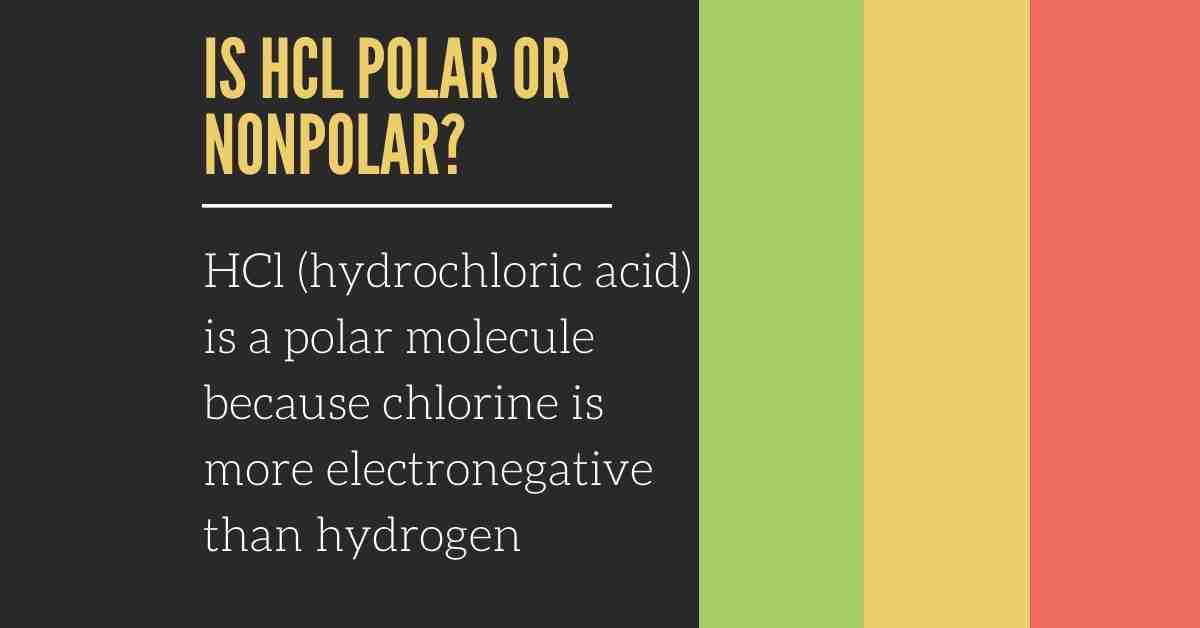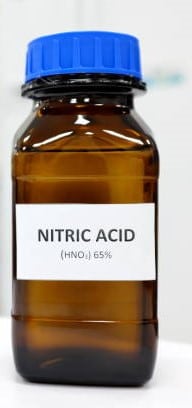Hydrogen chloride, a gas at room temperature and pressure, is a compound of hydrogen and chlorine elements. Hydrochloric acid (HCl) is a hydrogen chloride solution in water. HCl is a polar molecule as a more electronegative chlorine atom draws the bounded electron pair somewhat closer to it and acquires a partial negative charge, whereas hydrogen gains a partial positive charge. The dipole moment of HCl is 1.03 D.

So what are HCL intermolecular forces? In HCl, two intermolecular interactions exist, dipole-dipole forces and London dispersion forces. The dipole-dipole forces are the stronger of the two. The dipole-dipole forces are caused by the dipole of the H-Cl bond (as Cl is more electronegative than H).

Table of Contents
Hydrochloric Acid
Hydrochloric acid is a chemical compound that is made up of inorganic elements. It has a colorless appearance and is used in labs to make aqueous-based solutions.
Hydrochloric acid is a clear, colorless liquid with a pungent odor. In the form of an aqueous solution, it is commonly used in chemical laboratories in high schools and colleges.
When present in large amounts, this chemical exists as a liquid and emits vapors.
Hydrochloric acid has a molecular mass of 36.46 g/mol.
Hydrochloric Acid Hazards
The eyes, skin, and hydrochloric acid are corrosive to the eyes, skin, and mucous membranes. Acute (short-term) inhalation exposure in humans can result in irritation and inflammation of the eyes, nose, and respiratory tract, as well as pulmonary edoema.
Uses of Hydrogen Chloride (HCl)
Hydrochloric acid has a wide range of applications. It’s utilized in the manufacture of chlorides, fertilizer, and dyes, as well as in electroplating, photography, textiles, and rubber. The eyes, skin, and mucous membranes are all corroded by hydrochloric acid.
Related Links
SiO2 Lewis Structure| Step By Step Construction
Bromine Trifluoride(BrF3)|Bond Angle & Hybridization
N2 Lewis Structure| Hybridization & Molecular Geometry
Hydrogen Bond| Definition & Easy Explanation
H2S Lewis Structure & Molecular Geometry
Frequently Asked Questions
1. Polar covalent bond?
Polar molecules form when the electronegativity of the connected atoms changes. Nonpolar molecules are generated when electrons in a diatomic molecule are equitably shared or when polar bonds in a larger molecule cancel each other out.
2. What is a hydrogen bond?
A hydrogen bond (H-bond) is a dipole-dipole interaction. It is not an actual chemical bond.
It develops when a hydrogen atom is bonded to a strongly electronegative atom.
(fluorine, nitrogen, or oxygen) exists in the vicinity of another electronegative atom with a lone pair of electrons.
This type of bond is weaker than an ionic or covalent bond, but it is stronger than van der Waals forces.
3. What is the electronegativity difference?
Electronegativity is the tendency of an atom in a chemical bond to attract electrons to itself.
The larger the difference in electronegativity values between atoms, the more polar the chemical connection formed between them.
4. Define dipole moments
A dipole moment is simply a measurement of the net polarity of a molecule.
When polar bonds are irregularly distributed around the core of a molecule, resulting in a polar molecule, the charge distribution throughout the entire molecule is uneven.
Ammonia is an example of a polar molecule (Nh3).
The electrons they share are drawn to nitrogen because nitrogen attracts electrons more strongly than hydrogen.
5. CH4 polar or nonpolar?
CH4 is a nonpolar molecule.
CH4 has four identical C-H bonds and is an asymmetric tetrahedral geometrical structure. Carbon and hydrogen have electronegativity coefficients of 2.55 and 2.2, respectively, resulting in almost zero partial charges.
6. O2 polar or nonpolar?
The molecule O2 is a nonpolar one.
The four electrons that comprise the double bond between the oxygen atoms in the O2 molecule are equally shared by both oxygen atoms. Any element with identical electronegativity has no partial charges.
7. is CO polar?
CO (Carbon monoxide) is a polar molecule because of the electronegativity difference between C(2.55) and O(3.44) atoms. Both atoms have unequal charge distribution, and therefore the CO bond has a net dipole moment making it a polar molecule.
8. is carbon dioxide polar?
CO2 is nonpolar in nature because there is no uneven sharing of valence electrons.
Because of its linear, symmetrical form, carbon dioxide (CO2) is nonpolar. The electron density is taken equally from both sides of the carbon atom by the two oxygen atoms.
9. SO2 polar?
The gas sulfur dioxide (SO2) has a polar character. Because of the electronegativity mismatch between the sulfur (2.58) and oxygen (3.44) atoms, it is a polar molecule. Because of the presence of unbonded electrons on the sulfur and oxygen atoms, SO2 has a bent shape.
10. what is the gas produced when hydrochloric acid is reacted with ammonium carbonate?
When ammonium carbonate reacts with hydrogen chloride, ammonium chloride, carbon dioxide, and water are produced. As a result, carbon dioxide is generated.
More Interesting Links
Is HCl Polar or Nonpolar?
Is Nh3 Polar?
How cold is Liquid Nitrogen?
Is Chlorine a metal?
How Many Cups in a Gallon? Cups to Pints, Quarts
Alliteration Definition
What Is an Au Pair|Au Pair Meaning & Average pay
- BCl3 Lewis Structure in four simple steps - November 1, 2023
- PH3 Lewis Structure in four simple steps - October 8, 2023
- PF3 Lewis structure in four simple steps - September 24, 2023



